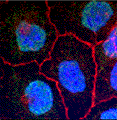Biochemistry, Department of
ORCID IDs
0000-0003-2397-3131 (JE Markham)
Document Type
Article
Date of this Version
7-2009
Citation
Plant Physiology (July 2009) 150: 1,174-1,191
doi: 10.1104/pp.109.137497
Abstract
In plants, very-long-chain fatty acids (VLCFAs; >18 carbon) are precursors of sphingolipids, triacylglycerols, cuticular waxes, and suberin. VLCFAs are synthesized by a multiprotein membrane-bound fatty acid elongation system that catalyzes four successive enzymatic reactions: condensation, reduction, dehydration, and a second reduction. A bioinformatics survey of the Arabidopsis (Arabidopsis thaliana) genome has revealed two sequences homologous to YBR159w encoding a Saccharomyces cerevisiae β-ketoacyl reductase (KCR), which catalyzes the first reduction during VLCFA elongation. Expression analyses showed that both AtKCR1 and AtKCR2 genes were transcribed in siliques, flowers, inflorescence stems, leaves, as well as developing embryos, but only AtKCR1 transcript was detected in roots. Fluorescent protein-tagged AtKCR1 and AtKCR2 were localized to the endoplasmic reticulum, the site of fatty acid elongation. Complementation of the yeast ybr159Δ mutant demonstrated that the two KCR proteins are divergent and that only AtKCR1 can restore heterologous elongase activity similar to the native yeast KCR gene. Analyses of insertional mutants in AtKCR1 and AtKCR2 revealed that loss of AtKCR1 function results in embryo lethality, which cannot be rescued by AtKCR2 expression using the AtKCR1 promoter. In contrast, a disruption of the AtKCR2 gene had no obvious phenotypic effect. Taken together, these results indicate that only AtKCR1 is a functional KCR isoform involved in microsomal fatty acid elongation. To investigate the roles of AtKCR1 in postembryonic development, transgenic lines expressing RNA interference and overexpression constructs targeted against AtKCR1 were generated. Morphological and biochemical characterization of these lines confirmed that suppressed KCR activity results in a reduction of cuticular wax load and affects VLCFA composition of sphingolipids, seed triacylglycerols, and root glycerolipids, demonstrating in planta that KCR is involved in elongation reactions supplying VLCFA for all these diverse classes of lipids.



Comments
Copyright 2009, American Society of Plant Biologists. Used by permission.